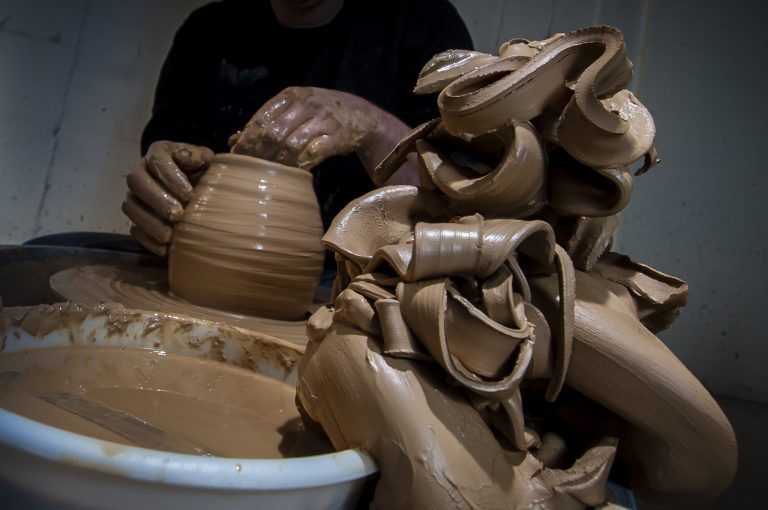
Image by Flavio Grynszpan/Flickr, Attribution.
The Clay Will Tell You How You Are
My fourth ceramics class began and ended calamitously, despite high expectations and a building confidence.
Working at the wheel, where I’d handily “thrown” a pot on my first try weeks before, my task was to wedge the clay to remove air and inconsistency, knead it into balls the size of oranges, slam them one at a time on the bull’s-eye of the wheel, and then hit the accelerator.
This first step — centering the clay — is much harder than it sounds, requiring stillness and concentration from the potter. Even if the clay is properly positioned when the wheel is stationary, a challenging task in itself, the flattened ball of clay can easily begin a wild wobble once the wheel begins its counter-clockwise spin.
The foot pedal, not used properly, adds to the problem. You need to reach it, without looking down, then apply exactly the right pressure. The brake and the accelerator are at opposite ends of the same pedal. Stomp your heel on the brake instead of your toe on the accelerator and the wheel screeches to a halt. Make the same mistake in reverse, accelerating instead of breaking when trying to slow the wheel down, and you’re driving 80 mph in a 45 mph zone.
On this night, neither hands nor feet would obey me. For two hours, the wild wobble at my wheel went from bad to worse until the clay became a projectile — flying once, twice, three times off the wheel, breaking apart and lodging in unreachable places in the splash pan. The catch basin filled with ruined clay and dirty water fit only for the recycle bin.

As my exasperation mounted, along with embarrassment that my classmates and teacher were watching, the clay took charge of me, not the other way around. Pressing the mound down beneath my palms, squeezing it up from the sides, opening the top with my fingers and then widening that opening, were distant memories from the early class. My hands were not mindfully guiding the clay but trying to force it to do my bidding. My feet didn’t seem attached to the rest of my body. Something I had done rather intuitively two weeks ago was no longer part of my muscle memory.
The flying wheel not only launched the clay into the splash pan, which would take an hour to clean at the end of class, but into the lap of the person to my left and the shoulder of the person to my right. “Sorry, sorry, sorry,” I mumbled, fighting back tears.
One teacher offered me wine (“No, thank you”). He urged me to take a walk (I did), have a glass of water (I found the fountain), and, most importantly of all, try to breathe. He adjusted my hands by cradling them in his own. He bent to move the pedal that had skidded across the floor so my foot could reach it. He eased my flailing leg back where it belonged.
The other teacher, good-humoredly, told me everyone had bad days and she wasn’t surprised that mine was today as Mercury was in retrograde, a time when life can go haywire, according to astrologers.
I don’t put any stock in astrology. I find “What’s your sign?” one of the most foolish questions in the world. I was still comforted — even after I got home and checked Google, only to find the most recent retrograde period was September 19 to October 9. My pottery mishap occurred on October 12. Oops.
“So what?” I decided. I’d rather be under the influence of the planets than responsible for myself.
Even twitching, blushing, and fighting the urge to flee the classroom, I still learned one precious lesson. “The clay will tell you how you are,” the teacher said, even if the message is that you’re in a very bad place.

The previous classes — making pinch pots, scoring and attaching coils, working at the rambunctious wheel — had begun with me centered, and then centered me even further.
Were these two hours fun like those other classes? Nope. Did I risk getting clay all over my iPhone by taking proud pictures? No, as I’d made nothing and the only thing to photograph was my corner of the room, slathered in wayward clay. Still, this new adventure has already succeeded beyond my wildest expectations.
I wanted to get out of my head and into my body, to silence the jabbering “monkey mind” that Buddhists warn make one unsettled, restless, confused. Swimming has always done that for me by counting laps: “One, one, one. Two, two, two. Three, three, three…” to crowd out thinking. Ceramics could quiet me, too, or send an instant signal that I was in a bad place, that I needed to slow myself down, breathe, control the clay, and let the wheel do its work.
Like a balancing pose in yoga, ceramics provides a perfect feedback loop: exit your body and enter your busy mind, and you will likely teeter and fall. Or, in this case, try to bully the clay with strength, not stillness, and it turns into a guided missile rather than a bowl.
The saving grace of this last class was that it nudged me in this direction of learning. It provided welcome calm, however belated, not at the wheel but at the sink. There, long after the others had gone, I was still washing the splash pan and a dozen tools I had used that were now unrecognizable under the gobs of clay.
As hot water ran over my hands, and I squeezed sponge after sponge until one was clean enough to scrub my work area, my breathing slowed and my shoulders unclenched and moved away from my ears.
The teacher’s voice followed me out the door:
“The more you get aggravated, the more you get aggravated.”

Share your reflection